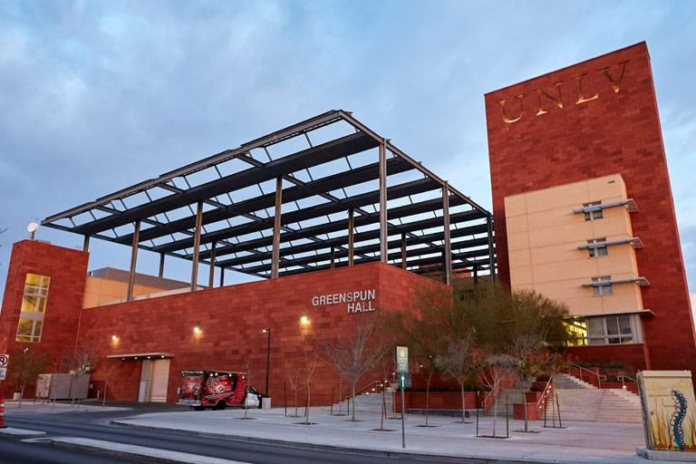It has been a little bit over two years since the world was changed by the COVID-19 pandemic. As much of the world changed to try and stop the spread of the virus, colleges around the country had to adjust to teaching students in a virtual environment.
For professors at UNLV’s Greenspun College of Urban Affairs, they had the difficult task of teaching their classes that are best-suited for in-person learning, with hands-on elements. And there were more struggles of balancing their lives of teaching during the pandemic.
One of those professors who had a tough challenge of teaching during the pandemic is UNLV communications professor Jenny Farrell. She describes her challenges between work and home life, which definitely gives an idea into how the pandemic affected not only students, but professors as well.
Farrell describes exactly how her experience teaching online impacted her, and not only Farrell but two other professors at UNLV, Matthew Perrault and Patrick Evans, also described their experiences during the pandemic.
In March of 2020, UNLV switched all classes to remote learning due to the spread of COVID-19. She faced many different challenges, but the most difficult one, managing life at home and not letting it interfere with her work as a professor.
“I was disappointed,” Farrell said on the initial announcement of classes being moved to remote learning. “I had two lecture classes and I love those classes, but I wasn’t worried about how the semester would play out.”
Farrell faced similar challenges as other professors during the pandemic. She came up with different ideas and adjusted her lesson plans for remote learning. Her web-based classes consisted of the Communications (COM) 102 class she taught that semester, but her COM 302 ended up switching to remote learning. Luckily for Farrell, her classes ran smoothly for her.
“My (COM) 302 class had to switch to online,” Farrell said. “I had already taught online so I had confidence to be able to make that transition.”
The lectures from in person compared to online classes pointed out a lot of similarities and differences for Farrell and other professors in the Urban Affairs College. When classes held in-person lessons, Farrells’ lecture heavy classes contained a lot of content, which made it easier to teach. Online classes made lectures a lot harder to teach, so she made her classes asynchronous for the sake of her students.
“Students don’t want to watch lectures,” Farrell said. “So, I didn’t want to add more stress to them when it was already a stressful time.”
The pandemic made the balance of work and home life harder for professors to manage. Professors took their work home, which made work harder especially with children in the household.
Farrell struggled teaching and taking care of her kids at home throughout the pandemic. She got most of her work done in three days to make time for her kids throughout each week.
Working and making time for her family challenged her weekly. For this reason, she decided to homeschool her kids for the time being. This helped not only her, but also her children and their education.
“It was terrible. I was doing it for 10 weeks and I couldn’t do it anymore,” Farrell said. “The day cares were still open which helped a lot.”
Attempting to show the same amount of attention between work and home made the transition even more difficult for her. Not only did this happen to Farrell, but another UNLV professor experienced this as well, Perrault, a journalism professor teaching an audio announcing class at UNLV.
“My class is basically required to be in-person, so yes, it was very hard at first,” Perrault said. “I had to do lots of trial and error for my classes.”
Perrault struggled with the similar challenges as Farrell. The only difference demonstrated for both professors showed the distance of work and home life. For Farrell the virus brought her work and home life too close. While Perrault needed to keep his distance from his family at home.
“I was vaccinated,” Perrault said. “I was afraid of bringing the virus to my daughter who is not vaccinated.”
Farrell shares another similarity in terms of teaching with a former UNLV professor, Evans. He taught for the very first time in the spring semester 2020, a sports and media class. He tried to keep his students engaged, just like Farrell. Although she used her asynchronous methods of teaching to keep her students engaged. Evans engaged on zoom with daily conversations about sports with his students to keep them interested and to keep himself sane.
“Having those conversations helped me a lot,” Evans said. “Just having people to talk to really helped me out and my students.”
Making those adjustments to the lectures showed its importance, not only for the students but for the professors as well. Having to deal with online teaching takes its toll on professors. Not only do these small adjustments help their lesson plans, but with their daily tasks as well.
“I needed to get out of the house and go back into the office,” Farrell said. “So, when they allowed us to go back I did.”
Once the university announced that there would be in-person and hybrid classes for the following semester, fall 2020, Farrell became excited to converse in-person again. Although she grew excited about coming back, she also became nervous.
“It felt good to be back, but I was waiting for that pushback from students that didn’t want to wear masks,” Farrell said. “I needed to think about a mask that would accommodate me because I do have a 3-hour lecture class.”
Although this pandemic hit the UNLV community unexpectedly, these professors handled it in their own ways. Some professors struggled more than others, depending on their situations. Despite the challenges Farrell faced, she learned a valuable lesson from this experience.
“The most important thing I learned was the work and home life balance,” Farrell said. “And that became clear.”

